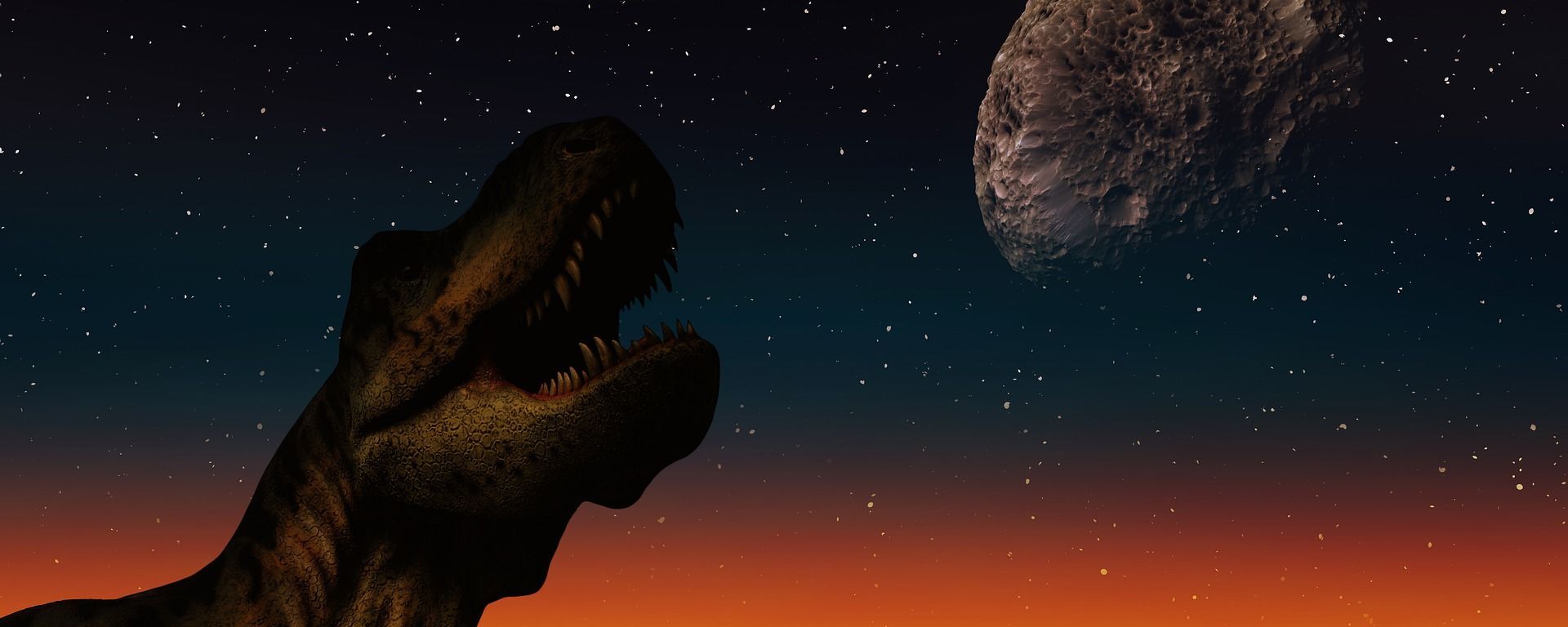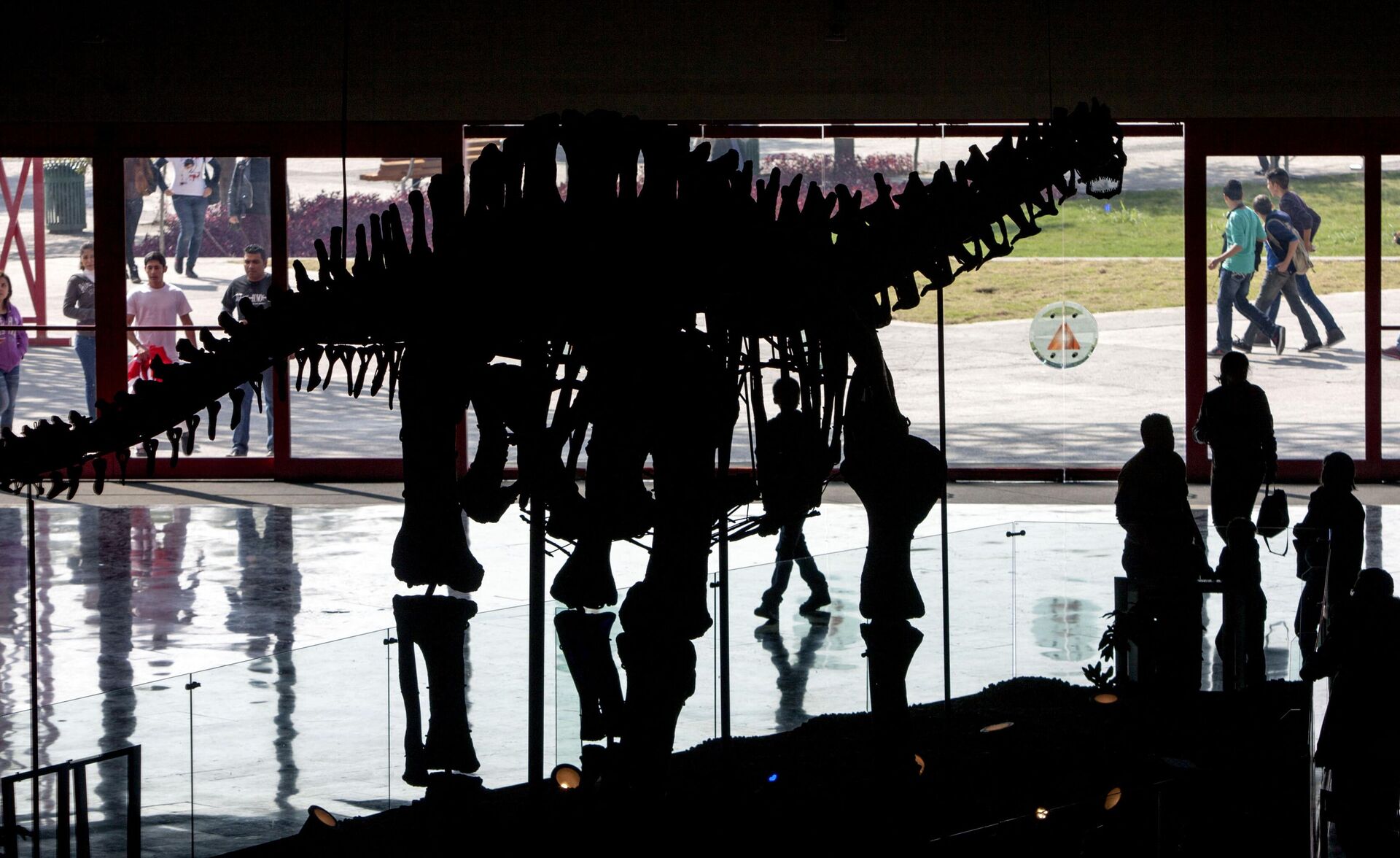https://sputnikglobe.com/20221228/friction--aerodynamic-drag-a-dinosaurs-thrashing-tail-failed-to-break-sound-barrier-study-shows-1105845490.html
Friction & Aerodynamic Drag: A Dinosaur's Thrashing Tail Failed to Break Sound Barrier, Study Shows
Friction & Aerodynamic Drag: A Dinosaur's Thrashing Tail Failed to Break Sound Barrier, Study Shows
Sputnik International
Friction and aerodynamic drag are some of the reasons why a dinosaur's thrashing tail failed to break the soundbarrier, study shows.
2022-12-28T13:18+0000
2022-12-28T13:18+0000
2022-12-28T13:18+0000
science & tech
dinosaur
sonic boom
speed of sound
sound barrier
https://cdn1.img.sputnikglobe.com/img/104345/38/1043453821_0:98:1670:1037_1920x0_80_0_0_461101220f6cddf0e8a8374bd7e627d5.jpg
Dinosaurs that became extinct about 65 million years ago after roaming the Earth for about 165 million years continue to fascinate scientists and laymen alike. This enthrallment with the inhabitants of the mesozoic era sometimes spawns unusual research collaborations. A case in point is the recent joint study by a group of paleontologists and aerospace engineers, entitled 'Multibody analysis and soft tissue strength refute supersonic dinosaur tail'.One of the many questions often debated about dinosaurs is why some of their species boasted such long slender tails. Some theories suggested that the towering dinosaurs in the sauropod group, which stood on four thick legs, used their tails for balance. Others suggest that sauropods, the best-known of which are the enormous Diplodocus and Brontosaurus, would whip their tails as a weapon. Interestingly, it has even been suggested that, given the length of the tail, the dinosaurs could whip the tip of their tail "supersonically". The scientists behind the latest study, led by paleontologist Simone Conti from NOVA University near Lisbon, Portugal, set out to investigate the truth of this. They simulated a dinosaur's tail with its 80 or so vertebrae as it lashed about, to see whether the appendage could break the sound barrier with a "supersonic boom".The research was hampered by the fact that a complete fossilized diplodocid tail has yet to be discovered. So what the team did was piece together remains from five fossilized dinosaurs, adding properties of skin, tendons, and ligaments as well. Skin thickness was based on crocodile skin.The simulation, accordingly, modelled the mechanical strain that these soft tissues could withstand as the tail lashed back and forth.The tail in the computer models weighed around 1,446 kilograms and measured 12 meters long. Simulating the mechanics of tail rotation and response of soft tissue, the team found that the aforementioned tails were "stiffer than previously thought, with an important role played by the tendons and musculature to avoid disarticulation of the vertebrae once the tail is set in motion."Because of friction of the tail muscles and vertebrae, along with aerodynamic drag, the tail moved at a speed of around 30 meters per second or 100 kilometers per hour at its tip, revealed the study. This is a tenth the speed of sound (approximately 340 meters per second in air at 20°C). Furthermore, the team stated that even if, theoretically, the simulated tail had broken the sound barrier, it would have snapped under such high strain.
https://sputnikglobe.com/20221005/asteroid-that-killed-the-dinosaurs-caused-a-global-tsunami-1101515003.html
Sputnik International
feedback@sputniknews.com
+74956456601
MIA „Rossiya Segodnya“
2022
News
en_EN
Sputnik International
feedback@sputniknews.com
+74956456601
MIA „Rossiya Segodnya“
Sputnik International
feedback@sputniknews.com
+74956456601
MIA „Rossiya Segodnya“
friction and aerodynamic drag, dinosaur's thrashing tail, fossil evidence, sauropod group, supersonically whip their tails, fossilized diplodocid tail, simulated a dinosaur's tail mechanics
friction and aerodynamic drag, dinosaur's thrashing tail, fossil evidence, sauropod group, supersonically whip their tails, fossilized diplodocid tail, simulated a dinosaur's tail mechanics
Friction & Aerodynamic Drag: A Dinosaur's Thrashing Tail Failed to Break Sound Barrier, Study Shows
According to fossil evidence, dinosaurs ranged in size from small, bird-like reptiles less than a meter long to huge, long-necked sauropods that measured up to 40 meters in length and boasted a tail span of up to 14 meters, if not more.
Dinosaurs that became extinct about 65 million years ago after roaming the Earth for about 165 million years continue to fascinate scientists and laymen alike. This enthrallment with the inhabitants of the mesozoic era sometimes spawns unusual research collaborations. A case in point is the recent
joint study by a group of paleontologists and aerospace engineers, entitled 'Multibody analysis and soft tissue strength refute supersonic dinosaur tail'.
One of the many questions often debated about dinosaurs is why some of their species boasted such long slender tails. Some theories suggested that the towering dinosaurs in the sauropod group, which stood on four thick legs, used their tails for balance. Others suggest that sauropods, the best-known of which are the enormous Diplodocus and Brontosaurus, would whip their tails as a weapon. Interestingly, it has even been
suggested that, given the length of the tail, the dinosaurs could whip the tip of their tail "supersonically".
The scientists behind the latest study, led by paleontologist Simone Conti from NOVA University near Lisbon, Portugal, set out to investigate the truth of this. They simulated a dinosaur's tail with its 80 or so vertebrae as it lashed about, to see whether the appendage could break the sound barrier with a "supersonic boom".
The research was hampered by the fact that a complete fossilized diplodocid tail has yet to be discovered. So what the team did was piece together remains from five fossilized dinosaurs, adding properties of skin, tendons, and ligaments as well. Skin thickness was based on crocodile skin.
The simulation, accordingly, modelled the mechanical strain that these soft tissues could withstand as the tail lashed back and forth.
The tail in the computer models weighed around 1,446 kilograms and measured 12 meters long. Simulating the mechanics of tail rotation and response of soft tissue, the team found that the aforementioned tails were "stiffer than previously thought, with an important role played by the tendons and musculature to avoid disarticulation of the vertebrae once the tail is set in motion."
Because of friction of the tail muscles and vertebrae, along with aerodynamic drag, the tail moved at a speed of around 30 meters per second or 100 kilometers per hour at its tip, revealed the study. This is a tenth the speed of sound (approximately 340 meters per second in air at 20°C). Furthermore, the team stated that even if, theoretically, the simulated tail had broken the sound barrier, it would have snapped under such high strain.

5 October 2022, 00:13 GMT




